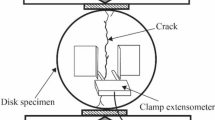Abstract
The goal of the research presented here was to study the relationship between cracking and water permeability. A feedback-controlled test was used to generate width-controlled cracks. Water permeability was evaluated by a low-pressure water permeability test. The factors chosen for the experimental design were material type (paste, mortar, normal and high strength concrete), thickness of the sample and average width of the induced cracks (ranging from 50 to 350 micrometers). The water permeability test results indicated that the relationships between permeability and material type differ for uncracked and cracked material, and that there was little thickness effect. Permeability of uncracked material decreased from paste, mortar, normal strength concrete (NSC) to high strength concrete (HSC). Water permeability of cracked material significantly increased with increasing crack width. For cracks above 100 microns, NSC showed the highest permeability coefficient, where as mortar showed the lowest one.
Résumé
Le but de la recherche présentée ici a été d'étudier la relation entre la fissuration d'un matériau et sa perméabilité à l'eau. Un essai avec contrôle par rétroaction a été utilisé pour générer des fissures d'ouverture contrôlée. La perméabilité à l'eau a été évaluée par un essai à basse pression. Les paramètres choisis pour la conception du programme expérimental ont été le type de matériau (pâte de ciment, mortier, béton ordinaire et béton à haute performance), l'épaisseur de l'échantillon et l'ouverture moyenne des fissures provoquées (variant de 50 à 350 micromètres). Les résultats des essais de perméabilité à l'eau montrent que les relations entre la perméabilité et le type de matériau diffèrent selon que le matériau est fissuré ou non, et que l'épaisseur de l'échantillon a peu d'influence sur la perméabilité. La perméabilité du matériau non fissuré est décroissante à partir de la pâte de ciment, le mortier, le béton ordinaire jusqu'à celle du béton à haute performance. La perméabilité du matériau fissuré augmente de façon significative lorsque l'ouverture des fissures s'agrandit. Pour les fissures de plus de 100 micromètres, on observe que le béton ordinaire présente le coefficient de perméabilité le plus élevé, et le mortier le coefficient le plus faible.
Similar content being viewed by others
References
Wang, K., Jansen, D., Shah, S. P. and Karr, A., ‘Permeability study of cracked concrete’,Cement and Concrete Research 27 (3) (1997) 381–393.
Gérard, B., Breysse, D., Ammouche, A., Houdusse, O. and Didry, O., ‘Cracking and permeability of concrete under tension’,Mater. Struct. 29 (187) (1996) 141–151.
Gérard, B., Marchand, J., Breysse, D. and Ammouche, A., ‘Constitutive law of high-performance concrete under tensile strain’, in ‘Utilization of High-Strength/High-performance Concrete’, Proceedings of the 4th International Symposium on Utilization of High-Strength/High-performance Concrete, Paris, May 1996 (Presses de l'École nationale des Ponts et chaussées, Paris, 1996) 677–685.
‘Standard test method for electrical indication of concrete's ability to resist chloride ion penetration’, Designation C 1202-94, Annual Book of ASTM Standards, 04.02 620–625.
Castro-Montero, A., Jia, Z. and Shah, S. P., ‘Evaluation of damage in brazilian test using holographic interferometry’,ACI Materials Journal 92 (3) (1995) 268–275.
Gettu, R., Mobasher, S., Carmona, S. and Jansen, D., ‘Testing of concrete under closed-loop control’,Advanced Cement-Based Materials 3 (2) (1996) 54–71.
Ludirdja, D., Berger, R. L. and Young, F., ‘Simple method for measuring water permeability of concrete’,ACI Materials Journal 86 (5) (1990) 433–439.
Ruettgers, A., Vidal, E. N. and Wing, S. P., ‘An investigation of the permeability of mass concrete with particular reference to Boulder Dam’, Journal of the American Concrete Institute—Proceedings (March–April 1935) 382–416.
Hearn, N., ‘Sturated Permeability of Concrete as Influenced by Cracking and Self-Sealing’, Ph. D. Thesis, (University of Cambridge, 1992).
Hearn N. and Morley C. T., ‘Self-sealing property of concrete—experimental evidence’,Mater. Struct. 30 (201) (1997) 404–411.
Cernica, J. N., ‘Geotechnical Engineering: Soil Mechanics’, 1st Edn. (John Wiley & Sons, Inc., New York, 1995).
Author information
Authors and Affiliations
Additional information
Editorial Note Dr. S. P. Shah is a RILEM Senior Member and is the Chairman of RILEM TC 148-SSC (Test methods for the strain softening response of concrete). He is a member of RILEM TC 162-TDF (Test and design methods for steel fibre reinforced concrete) and of TC EAS (Early age shrinkage induced stresses and cracking in cementitious systems). Prof. Shah is a member of the Management Advisory Committee of RILEM. Surendra Shah is also editor in chief of Concrete Science and Engineering, a scientific journal published quarterly by RILEM Publications S. A. R. L.
Rights and permissions
About this article
Cite this article
Aldea, C.M., Shah, S.P. & Karr, A. Permeability of cracked concrete. Mat. Struct. 32, 370–376 (1999). https://doi.org/10.1007/BF02479629
Received:
Accepted:
Issue Date:
DOI: https://doi.org/10.1007/BF02479629




